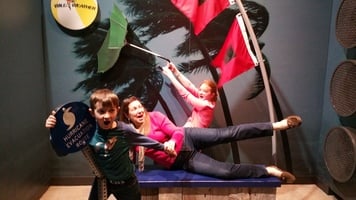The stories of ordinary children who faced extraordinary circumstances can inspire children today to fight discrimination and intolerance. The Power of Children: Making a Difference, a new exhibition at the Environmental and Heritage Center (EHC) through October 20th, explores the lives and positive impact of Anne Frank, Ruby Bridges and Ryan White.
The Power of Children encourages children and families to explore problems of isolation, fear and prejudice by giving a personal face to three major issues of the 20th century: the Holocaust, the Civil Rights movement and the AIDS epidemic. Through audio-visual presentations, original artifacts and hands-on interactive displays, visitors will get to know each child’s story, and immersive environments will bring them into the spaces where each child felt safe.
 Anne Frank, May 1942. Courtesy AFF/AFS
Anne Frank, May 1942. Courtesy AFF/AFSBecause of her Jewish heritage and faith, Anne Frank spent two years hiding from the Nazis in an annex behind her father’s office in Amsterdam during World War II. Anne dreamed of becoming a writer and while in hiding she kept a diary about her fears, experiences and thoughts of a better future. Despite her death at a concentration camp in 1945, the power of Anne’s words continues to reach millions through her widely published diary.

Ruby Bridges, 1960. Donated by Corbis
In 1960, six-year-old Ruby Bridges broke racial barriers by walking through an angry mob to her classroom each day, a key event in the struggle for Civil Rights that was immortalized by Norman Rockwell in his painting “The Problem We All Live With.” Today, years after making her mark on the Civil Rights movement, Ruby continues her fight against racism and hate through The Ruby Bridges Foundation, which provides educational resources and information to children, teachers and parents nationwide.
Ryan White, c.1987. © Kim Komenich
As an infant, Ryan White was diagnosed with hemophilia, and in 1984, he learned he had contracted the AIDS virus from a tainted treatment for his disease. When school officials learned of his condition, Ryan was banned from returning to school because of fears and misconceptions associated with HIV/AIDS. Ryan decided to fight back and found a voice as an advocate for AIDS research and education. Today, the Ryan White HIV/AIDS Program provides care and treatment for people with HIV/AIDS.
The Power of Children aspires to show the power words, actions and voice can have when people are faced with hatred, racism and discrimination. At the exhibition’s end, visitors are challenged to find ways that they can make a difference.
“This exhibit is very impactful and shows the power of youth. Getting a sense of the room where Anne Frank and her family hid from the Nazis, seeing a replica of the classroom where Ruby Bridges and her teacher spent an entire year together and getting to know Ryan White through the items he kept in his room gives inspiration to the idea that one person can indeed make a difference,” said EHC Director of Programming Jason West.
The exhibit is recommended for ages eight and up and is included in EHC admission. It will be on display at the EHC until October 20, 2015. For more information about The Power of Children and the EHC, visit
https://gwinnettehc.org/
https://gwinnettehc.org/



